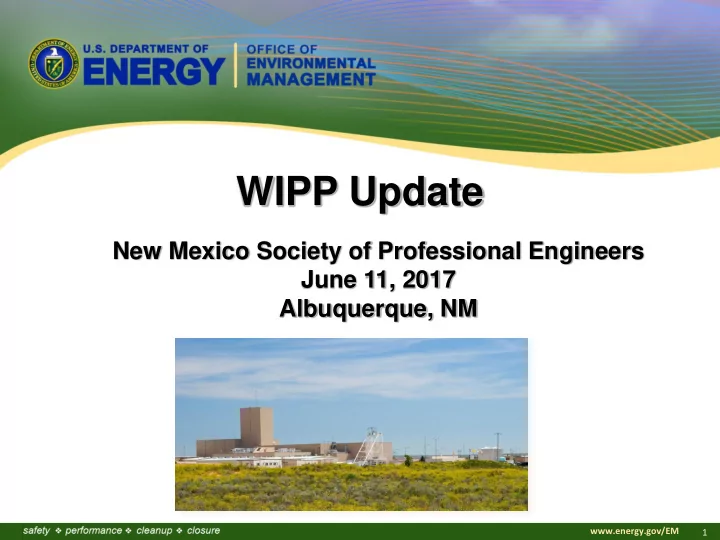

WIPP Update New Mexico Society of Professional Engineers June 11, 2017 Albuquerque, NM www.energy.gov/EM 1
WIPP Configuration 2 www.energy.gov/EM 2
WI WIPP PP Bac ackground ound Facility mined in salt: 2,150 feet deep in ancient salt formation that closes in and entombs waste forever 3 www.energy.gov/EM 3
WIPP Underground Map 4 www.energy.gov/EM 4
WIPP Routes 5 www.energy.gov/EM 5
Types of Shipments Anticipated RH-72B TRUPACT-II TRUPACT-III HalfPACT www.energy.gov/EM 6
WIPP Status • Prior to 2014: 11,897 shipments from 22 sites around the country • Shipments made 1999 through 2014 • Waste receipt and emplacement suspended in February 2014 due to two events: • Fire on underground vehicle • Thermal event in an emplaced drum 7 www.energy.gov/EM 7
Timeline • Events occurred in February 2014 • Approximately nine months needed to return to limited underground operations • Original re-start date set for March 2016 • New re-start date December 2016 www.energy.gov/EM 8
Manage the Message • Baseline was approved and publicly released in late January 2016 • What completion date should be discussed internally? • What completion date should be discussed externally? • When schedule slip occurs, how should it be communicated? www.energy.gov/EM 9
Air Quality in the Underground • VOC are a common off-gas from the disposed waste • Due to diffusion through porous salt, VOC’s can occur in occupied areas even though waste is behind sealed bulkheads • Carbon Monoxide is a combustion product from underground diesel equipment • Low underground ventilation rates can lead to build-up of air contaminates in work areas • In March, 2016 timeframe, multiple incidents illustrated needed improvements in worksite air monitoring program • Alarm set points re-set based on recommendations from IH workshop and regulations • Number of alarms in worksites began increasing • What path forwarded should be initiated to keep work going? www.energy.gov/EM 10
Schedule and Budget Concerns • Mounting schedule concerns led to a series of meetings with headquarters over the summer to discuss path forward • Congressional and stakeholder concern over schedule was mitigated by increasing the interactions with these groups • Tension existed between raising expectations and need for transparency • How would you incentivize completion? www.energy.gov/EM 11
Interim Ventilation System www.energy.gov/EM 12
Interim Ventilation System • Contractor performed a Contractor Readiness Assessment • CBFO performed a Line Management Review in parallel • CBFO determined Contractor Readiness Review was ineffective and recommends repeating it • IVS will double underground air flow • Should the RA be repeated? www.energy.gov/EM 13
Ground Control • Ground control is biggest risk mitigation for underground work • Ground will heave on floor, scale on ribs, and fall on back www.energy.gov/EM 14
Ground Control • A series of rock falls occurred in prohibited areas beginning in September 2016 www.energy.gov/EM 15
Ground Control • Operations limited by lack of airflow • At most four bolters available • At the time, worker safety concerns were increasing • MSHA recommending more areas should be prohibited • What path should be taken to allow work to continue? www.energy.gov/EM 16
Readiness Activities • MSA performed in September, 2016 – Six pre-start findings • Contractor ORR performed in October, 2016 – Seven pre-starts and five post-start findings • Calendar indicates DOE ORR can start in mid- November • CBFO Line Management has concerns with proceeding with the DOE ORR • Should DOE ORR be performed and when? www.energy.gov/EM 17
Authorization to Proceed • ORR completed the first week of December • 21 pre-start findings from DOE ORR • DOE ORR team recommended team member concur on CAP and validation packages • Completion of all pre-start actions on December 22, 2016 • When should authorization be given? • When should first emplacement be performed? www.energy.gov/EM 18
WIPP Re-Opening www.energy.gov/EM 19
WIPP Status • Significant changes to site safety management programs • Extensive readiness activities performed in 2016 • DOE/State of NM authorized operations in December 2016 • First emplacement in early January 2017 • First shipments received in early April 2017 20 www.energy.gov/EM 20
Questions 21 www.energy.gov/EM 21
Recommend
More recommend